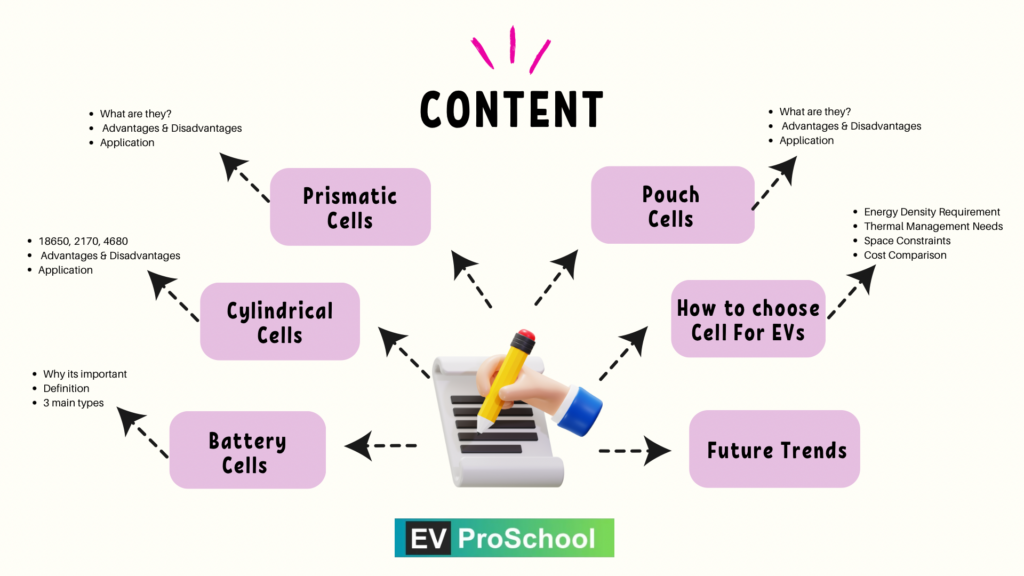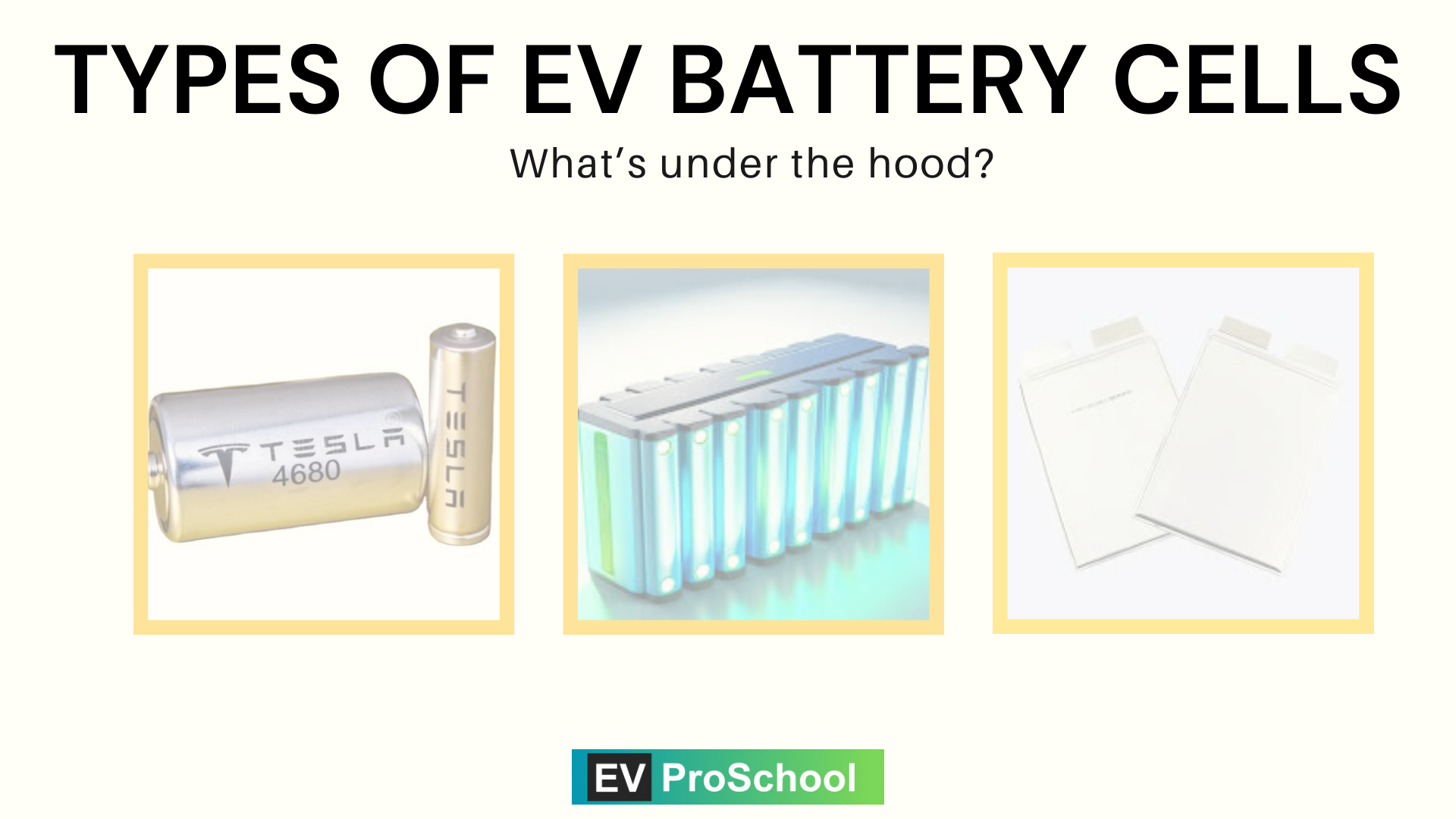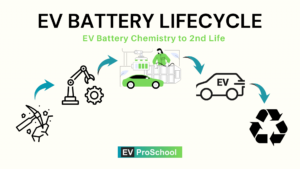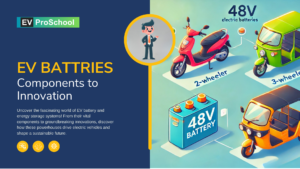Introduction: Hook the Reader
• Start with a compelling statement:
“Did you know the type of battery cell in your EV could determine its range, charging speed, and even its price? Let’s break down the three core types of EV cells driving the electric revolution.”
• Briefly introduce the three main types of EV cells (cylindrical, prismatic, and pouch).
• Set the tone for the post: an easy-to-follow guide to understanding EV cell technology.

What Are Battery Cells
• Define what a battery cell is (the smallest energy-storing unit in a battery).
• Explain their role in EV performance:
• Energy density (range).
• Power output (acceleration).
• Durability and lifespan.
• Introduce the three main types of EV cells.
Cylindrical Cells
• What Are They?
• Small cylindrical shapes (like AA batteries). Common examples include:
• 18650: 18mm diameter, 65mm height.
• 2170: 21mm diameter, 70mm height (used by Tesla).
• 4680: 46mm diameter, 80mm height (Tesla’s next-gen cell).
• Advantages:
• High structural integrity: Resists deformation under pressure.
• Thermal management: Efficient heat dissipation.
• Manufacturing scalability: Widely used and cost-effective.
• Disadvantages:
• Limited space efficiency (cylindrical shapes leave gaps).
• Applications:
• Used in Tesla, Rivian, and Lucid Motors due to high energy density and scalability.
• Visual Idea: Diagram showing the structure of a cylindrical cell and how it’s connected in a battery pack.
Prismatic Cells
• What Are They?
• Rectangular cells with a rigid metal or aluminum casing.
• Advantages:
• Compact design: Fits into tight spaces, maximizing battery space in EVs.
• Simpler assembly: Fewer cells needed to achieve the same capacity.
• Disadvantages:
• Heavier due to metal casing.
• Lower heat dissipation than cylindrical cells.
• Applications:
• Common in passenger vehicles like the BMW i3 and electric buses.
• Visual Idea: Side-by-side comparison of prismatic and cylindrical cells.
Pouch Cells
• What Are They?
• Thin, flat cells encased in a flexible, lightweight foil.
• Advantages:
• Lightweight: Eliminates heavy casings.
• Flexible design: Can be customized to fit various shapes and sizes.
• High energy density: More energy in less space.
• Disadvantages:
• Vulnerable to swelling and damage without additional structural support.
• Requires robust thermal management systems.
• Applications:
• Common in compact EVs and high-performance sports cars.
• Visual Idea: Exploded view of a pouch cell with key components labeled.
How Are Cell Types Chosen for EVs?
• Discuss factors manufacturers consider when selecting cell types:
• Energy density requirements: Long-range vehicles need denser cells.
• Cost: Cylindrical cells are cheaper to produce than prismatic or pouch cells.
• Thermal management needs: Cylindrical cells dissipate heat better, while pouch cells require additional cooling.
• Space constraints: Pouch and prismatic cells are better for compact EVs.
Future Trends in EV Cells
• Explore innovations shaping the next generation of battery cells:
• 4680 cells: Tesla’s cylindrical cells with higher energy density and cost efficiency.
• Solid-state batteries: Eliminating liquid electrolytes for better safety and energy density.
• Sodium-ion cells: A cheaper alternative for small EVs.
• Mention how the industry is focusing on sustainability, such as recyclability and reduced cobalt use.
Conclusion
• Reinforce the idea that the type of cell affects EV performance, cost, and future innovation.
• End with a call-to-action:
• “As battery technology evolves, understanding EV cells gives us insight into how the future of electric mobility is being shaped. Want to dive deeper? Check out our guide to EV battery efficiency!”
3. Writing Style
• Tone: Friendly and conversational, but backed with technical clarity.
• Engagement Hooks: Use relatable comparisons (e.g., “Imagine your EV battery as a LEGO set. Each cell is a brick, and the type of brick determines how the structure holds together.”).
• Use rhetorical questions to pique curiosity: “Why are Tesla’s 4680 cells considered revolutionary? Let’s find out.”
4. Suggested Visuals and Graphics
• Infographics:
• A side-by-side comparison of cylindrical, prismatic, and pouch cells, showing pros/cons.
• A flowchart explaining how cells are connected into modules and then packs.
• Diagrams:
• Cross-sections of each cell type with labeled components.
5. SEO Strategy
• Primary Keywords: Types of EV cells, cylindrical cells, prismatic cells, pouch cells, EV battery design.
• Meta Description:
“Discover the core types of EV battery cells—cylindrical, prismatic, and pouch—and learn how they shape electric vehicle performance, safety, and cost.”
6. Suggested Blog Length
• Target 1,500–1,800 words, balancing technical details with readability.
With this strategy, the blog will provide an engaging, informative, and visually appealing overview of EV cell types, helping readers better understand their significance in electric mobility.


